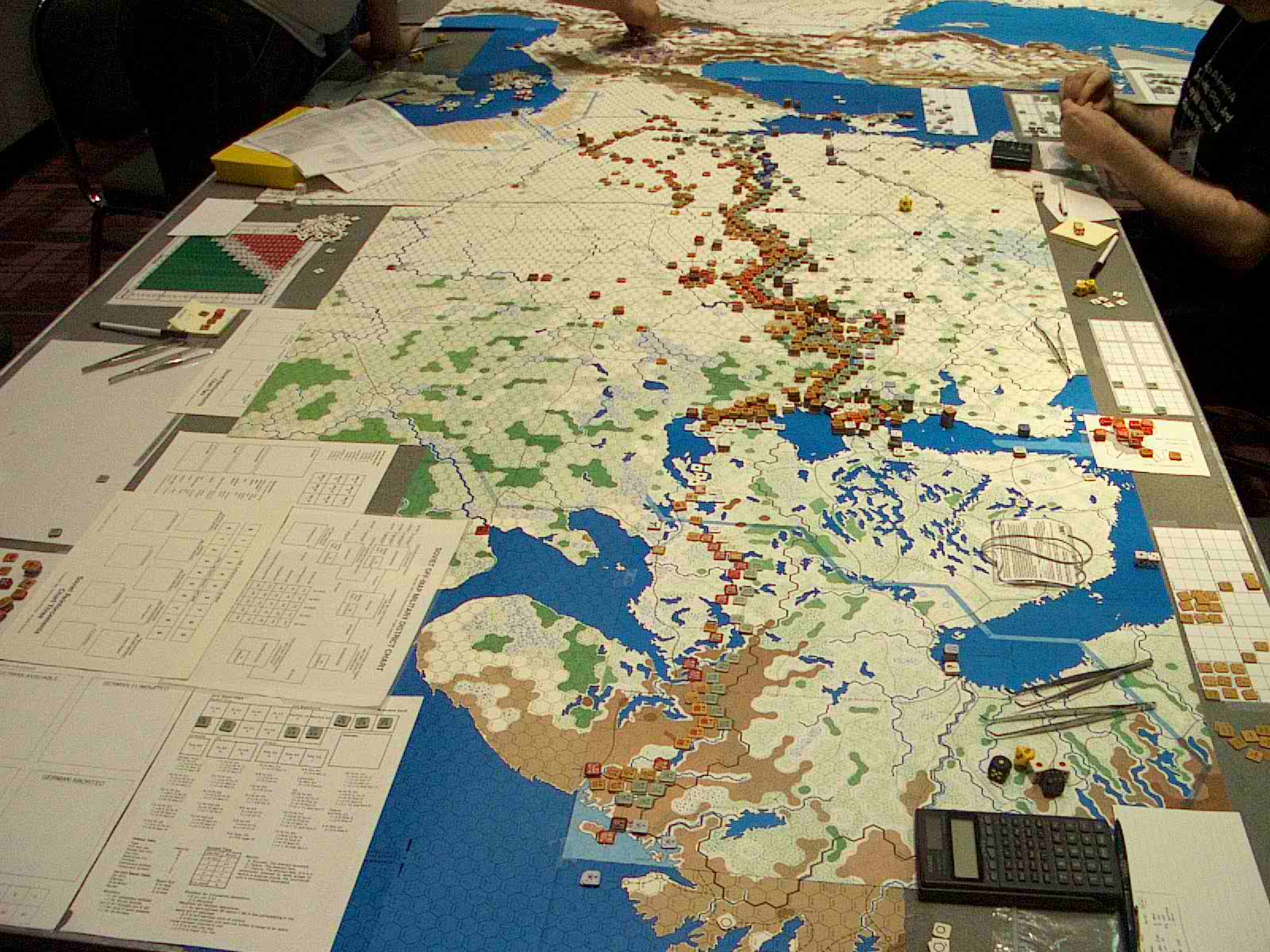Anatomy of a Wargame
Some readers will not be familiar with the genre of board wargaming. Below is a large-scale example of the type, a game entitled Europa, actually a composite of a series of games originally published in the 1980s, laid out for play at Origins 2006. It depicts all of WWII in Europe, the Mid-East, and the Soviet Union. Each hex represents 16 miles, each game turn represents two weeks, and units (the individual counter tokens) are typically divisions.

Photo credit: Michael Dye. Used with permission.
Things to notice:
- Wargames have to manifest some degree of historical specificity to be differentiated from popular but generic conflict games like Stratego or Risk. The popular Axis and Allies franchise (Hasbro) or more recently Memoir ’44 (Days of Wonder) represent about the minimum history acceptable in this regard. Unlike many Euro games, where the nominal historical subject is nothing but a thematic skin for the underlying game engine, board wargames try to capture some salient aspect of the events they depict, be it a particular strategic dilemma, operational opportunity or challenge, or battlefield dynamic.
- The game map depicts a large portion of Asia and continental Europe. A hexagonal grid is superimposed over the map, to regulate the placement and movement of the pieces. The predominant terrain type in each hex is graphically indicated.
- The playing pieces, many hundreds of them, represent either individual military units or “markers” which serve to indicate the state and condition of individual units—for example, a unit which is disorganized by combat might be covered by a marker to indicate its status.
- Wargames come in different scales, generally referred to as strategic, operational, or tactical. A strategic game such as Europa offers the big picture of an entire conflict or theater. Turns typically represent weeks, months, or even years (one recent release covers the entire 30-year Peloponnesian War with seasonal turns.) An operational level game depicts a specific set of operations or campaign, such as the D-Day landings in Normandy. Turns typically cover days or possibly half-days. Tactical level games focus on an individual battle, such as Waterloo or Gettysburg. Turns may depict a half or hour of the actual fighting. Some games are even smaller in focus, recreating individual skirmishes and firefights—the struggle for some anonymous hilltop in the Ardennes, for example. Advanced Squad Leader is the epitome of the form.
- Dice are typically used to resolve combat and other ambiguities of the battlefield. Six-sided and ten-sided dice are the most common. Most wargames offer a balance between chance and skill. (See Bowen Simmons’s essay in the sidebar.)
- Also visible are various charts and tables related to the play of the game. A Combat Results Table, or CRT, is a standard feature of most wargames. Here is a simple CRT, where the various outcomes—such as Attacker Retreats, Defenders Retreats, Exchange, Attacker Eliminated, or Defender Eliminated—are a function of the odds. A die is then rolled, with luck allowing for unlikely outcomes (an attack of 3:1 odds failing, for example). Odds or the die roll can be modified by terrain and other factors.
- Most wargames are played in turns, each turn consisting of various phases or steps which must be executed in sequence. The simplest turn structures are known as “igo-ugo,” meaning the players alternate actives roles (like in Chess–first one goes, then the other goes), but there are many more subtle or “interactive” ways of structuring the turn sequence. For example, the defender’s units may be given opportunities to move or engage as a reaction in the midst of an attacking player’s turn.
- Unlike Chess or many other boardgames, a player is usually free to move as many pieces as he or she likes during their player turn (though other kinds of constraints, such as whether a unit is in command or not, may prevent this). So while a Chess player agonizes over which piece to select, a wargame player is often moving dozens of units at a time. This makes playing a wargame “feel” very different from many other boardgames, which focus on selection of a single optimal move.
- A game will have “victory conditions,” which each player is attempting to fulfill. The most common kinds of victory conditions are based on achieving geographical objectives or inflicting casualties on the enemy. Some wargames, which portray an inherently unbalanced situation (the German invasion of France in 1940, for example) measure victory by whether or not a player outperforms their historical counterpart, even if they “lose” in terms of the actual situation.

A final point. Hovering over the maps, the players occupy an implicit position in relation to the game world. They enjoy a kind of omniscience that would be the envy of any historical commander, their perspectives perhaps only beginning to be equaled by today’s real-time intelligence with the aid of GPS, battlefield LANs, and 21st century command and control systems. The player’s relationship to the game is (to me) one of the most interesting aspects of board wargames, and I intend to explore it at length here in Zone of Influence. For now, suffice to say that “fog of war,” chaos, and friction are de facto qualities of any military situation, and they have been expressed, with varying degrees of verisimilitude, in existing game mechanisms.
Napoleon at Waterloo, a classic game originally published by SPI in 1979 (and the source of the CRT above), is available in its entirety for inspection and download here.